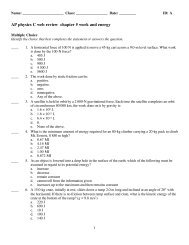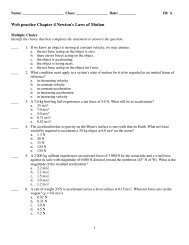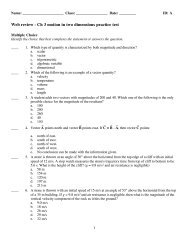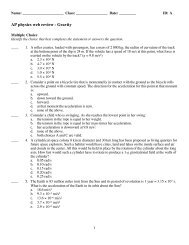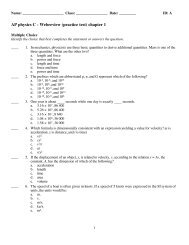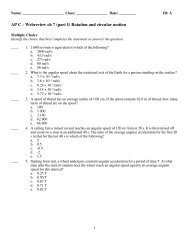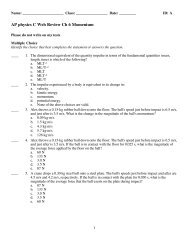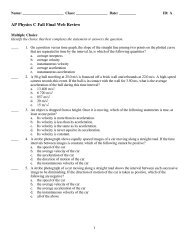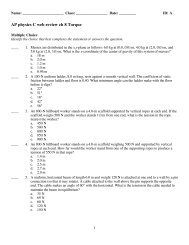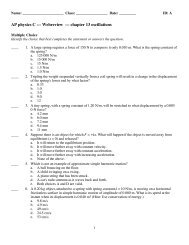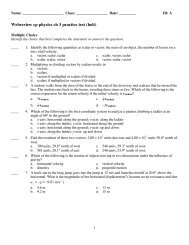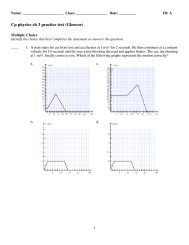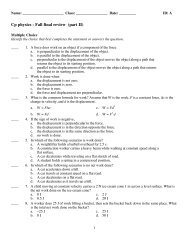AP physics B web review ch 15 electric forces and fields
AP physics B web review ch 15 electric forces and ... - Planet Holloway
AP physics B web review ch 15 electric forces and ... - Planet Holloway
Create successful ePaper yourself
Turn your PDF publications into a flip-book with our unique Google optimized e-Paper software.
Name: ______________________ Class: _________________ Date: _________<br />
ID: A<br />
<strong>AP</strong> <strong>physics</strong> B <strong>web</strong> <strong>review</strong> <strong>ch</strong> <strong>15</strong> <strong>electric</strong> <strong>forces</strong> <strong>and</strong> <strong>fields</strong><br />
Please do not write on my tests<br />
Multiple Choice<br />
Identify the <strong>ch</strong>oice that best completes the statement or answers the question.<br />
____<br />
____<br />
____<br />
____<br />
____<br />
1. If body M, with a positive <strong>ch</strong>arge, is used to <strong>ch</strong>arge body N by induction, what will be the nature of<br />
the <strong>ch</strong>arge left on the latter?<br />
a. must be equal in magnitude to that on M<br />
b. must be negative<br />
c. must be positive<br />
d. must be greater in magnitude than that on M<br />
e. must be positive on the surface of N<br />
2. If the distance between two point <strong>ch</strong>arges is tripled, the mutual force between them will be <strong>ch</strong>anged by<br />
what factor?<br />
a. 9.0<br />
b. 3.0<br />
c. 0.33<br />
d. 1/9<br />
e. 6.0<br />
3. Two point <strong>ch</strong>arges, separated by 1.5 cm, have <strong>ch</strong>arge values of +2.0 <strong>and</strong> −4.0 µC, respectively. What<br />
is the value of the mutual force between them? (ke = 8.99 × 10 9 N⋅m 2 /C 2 )<br />
a. 320 N<br />
b. 3.6 × 10 −8 N<br />
c. 8.0 × 10 −12 N<br />
d. 3.1 × 10 −3 N<br />
e. 16 N<br />
4. In a thundercloud there may be an <strong>electric</strong> <strong>ch</strong>arge of +40 C near the top of the cloud <strong>and</strong> −40 C near<br />
the bottom of the cloud. These <strong>ch</strong>arges are separated by about 2.0 km. What is the <strong>electric</strong> force<br />
between these two sets of <strong>ch</strong>arges? (ke = 8.99 × 10 9 N·m 2 /C 2 )<br />
a. 3.6 × 10 4 N<br />
b. 3.6 × 10 5 N<br />
c. 3.6 × 10 6 N<br />
d. 3.6 × 10 7 N<br />
e. 3.6 × 10 8 N<br />
5. An electron is sent at high speed toward a gold nucleus (<strong>ch</strong>arge +79e). What is the <strong>electric</strong>al force<br />
acting on the electron when it is 3.0 × 10 −14 m away from the gold nucleus? (e = 1.6 × 10 −19 C, ke =<br />
8.99 × 10 9 N·m 2 /C 2 )<br />
a. 20 N<br />
b. 0.25 N<br />
c. 2.0 × 10 −4 N<br />
d. 2.1 × 10 −6 N<br />
e. 4.8 × 10 −10 N<br />
1
Name: ______________________<br />
ID: A<br />
____ 6. Two electrons are separated by one cm. What is the ratio of the <strong>electric</strong> force to the gravitational force<br />
between them? (me = 9.11 × 10 −31 kg, ke = 8.99 × 10 9 N⋅m 2 /C 2 , G = 6.67 × 10 -11 N⋅m 2 /kg 2 , <strong>and</strong> e =<br />
1.6 × 10 −19 C)<br />
a. 2.3 × 10 2<br />
b. 1.3 × 10 20<br />
c. 3.1 × 10 22<br />
d. 4.2 × 10 42<br />
e. 8.0 × 10 44<br />
____ 7. A 6.00 µC <strong>ch</strong>arge is placed at the origin <strong>and</strong> a second <strong>ch</strong>arge is placed on the x-axis at x = 0.300 m.<br />
If the resulting force on the second <strong>ch</strong>arge is 6.40 N in the positive x-direction, what is the force on<br />
the <strong>ch</strong>arge at the origin?<br />
a. 6.40 N in the positive x-direction<br />
b. 6.40 N in the negative x-direction<br />
c. 0 N<br />
d. not able to be determined until the second <strong>ch</strong>arge is known<br />
e. a 6.00 µC <strong>ch</strong>arge cannot act with a force of 6.40 N<br />
____ 8. Two point <strong>ch</strong>arges are separated by 10.0 cm <strong>and</strong> have <strong>ch</strong>arges of +2.00 µC <strong>and</strong> −2.00 µC,<br />
respectively. What is the <strong>electric</strong> field at a point midway between the two <strong>ch</strong>arges? (ke = 8.99 × 10 9<br />
N·m 2 /C 2 )<br />
a. 28.8 × 10 6 N/C<br />
b. 14.4 × 10 6 N/C<br />
c. 7.19 × 10 6 N/C<br />
d. 3.59 × 10 6 N/C<br />
e. zero<br />
____ 9. Charges of 4.0 µC <strong>and</strong> −6.0 µC are placed at two corners of an equilateral triangle with sides of 0.10<br />
m. At the third corner, what is the <strong>electric</strong> field magnitude created by these two <strong>ch</strong>arges? (ke = 8.99 ×<br />
10 9 N·m 2 /C 2 )<br />
a. 4.5 × 10 6 N/C<br />
b. 3.1 × 10 6 N/C<br />
c. 1.6 × 10 6 N/C<br />
d. 4.8 × 10 6 N/C<br />
e. 7.5 × 10 6 N/C<br />
____ 10. A proton initially moves left to right long the x axis at a speed of 2.00 × 10 3 m/s. It moves into an<br />
<strong>electric</strong> field, whi<strong>ch</strong> points in the negative x direction, <strong>and</strong> travels a distance of 0.200 m before coming<br />
to rest. What acceleration magnitude does the proton experience?<br />
a. 6.67 × 10 3 m/s 2<br />
b. 1.00 × 10 7 m/s 2<br />
c. 9.33 × 10 9 m/s 2<br />
d. 2.67 × 10 11 m/s 2<br />
e. 5.52 × 10 14 m/s 2<br />
2
Name: ______________________<br />
ID: A<br />
____<br />
11. Two <strong>ch</strong>arges, +Q <strong>and</strong> −Q, are located two meters apart <strong>and</strong> there is a point along the line that is<br />
equidistant from the two <strong>ch</strong>arges as indicated. Whi<strong>ch</strong> vector best represents the direction of the<br />
<strong>electric</strong> field at that point?<br />
____<br />
a. Vector EA<br />
b. Vector EB<br />
c. Vector EC<br />
d. The <strong>electric</strong> field at that point is zero.<br />
e. The <strong>electric</strong> field is opposite to EB.<br />
12. A <strong>ch</strong>arge of +2 C is at the origin. When <strong>ch</strong>arge Q is placed at 2 m along the positive x axis, the<br />
<strong>electric</strong> field at 2 m along the negative x axis becomes zero. What is the value of Q?<br />
____<br />
____<br />
a. −3 C<br />
b. −6 C<br />
c. −7 C<br />
d. −8 C<br />
e. −10 C<br />
13. Electrons in a particle beam ea<strong>ch</strong> have a kinetic energy of 3.2 × 10 −17 J. What is the magnitude of the<br />
<strong>electric</strong> field that will stop these electrons in a distance of 0.1 m? (e = 1.6 × 10 −19 C)<br />
a. 200 N/C<br />
b. 1 000 N/C<br />
c. 2 000 N/C<br />
d. 4 000 N/C<br />
e. 10 000 N/C<br />
14. The <strong>electric</strong> field associated with a uniformly <strong>ch</strong>arged hollow metallic sphere is the greatest at:<br />
a. the center of the sphere.<br />
b. the sphere's inner surface.<br />
c. infinity.<br />
d. the sphere's outer surface.<br />
e. points inside the sphere.<br />
3
Name: ______________________<br />
ID: A<br />
____<br />
____<br />
____<br />
____<br />
____<br />
<strong>15</strong>. At what point is the <strong>ch</strong>arge per unit area greatest on the surface of an irregularly shaped conducting<br />
solid?<br />
a. where surface curves inward<br />
b. where surface is flat<br />
c. where curvature is least<br />
d. where curvature is greatest<br />
e. where surface curves outward<br />
16. We have an initially un<strong>ch</strong>arged hollow metallic sphere with radius of 5.0 cm. I place a small object<br />
with a <strong>ch</strong>arge of +10 µC at the center of the sphere through a hole in the surface. Find the <strong>electric</strong><br />
field present at a point 10 cm from the sphere's center. (ke = 8.99 × 10 9 N⋅m 2 /C 2 )<br />
a. 1.1 × 10 6 N/C<br />
b. 2.3 × 10 6 N/C<br />
c. 9.0 × 10 6 N/C<br />
d. 36 × 10 6 N/C<br />
e. 97 × 10 6 N/C<br />
17. A ping-pong ball covered with a conducting graphite coating has a mass of 5.0 × 10 −3 kg <strong>and</strong> a<br />
<strong>ch</strong>arge of 4.0 µC. What <strong>electric</strong> field directed upward will exactly balance the weight of the ball? (g =<br />
9.8 m/s 2 )<br />
a. 8.2 × 10 2 N/C<br />
b. 1.2 × 10 4 N/C<br />
c. 2.0 × 10 −7 N/C<br />
d. 5.1 × 10 6 N/C<br />
e. 3.4 × 10 −3 N/C<br />
18. Two identical balls have the same amount of <strong>ch</strong>arge, but the <strong>ch</strong>arge on ball A is positive <strong>and</strong> the<br />
<strong>ch</strong>arge on ball B is negative. The balls are placed on a smooth, level, frictionless table whose top is an<br />
insulator. Whi<strong>ch</strong> of the following is true?<br />
a. Since the force on A is equal but opposite to the force on B, they will not move.<br />
b. They will move together with constant acceleration.<br />
c. Since the force on both balls is negative they will move in the negative direction.<br />
d. Since the <strong>forces</strong> are opposite in direction, the balls will move away from ea<strong>ch</strong> other.<br />
e. None of the above is correct.<br />
19. A thin un<strong>ch</strong>arged conducting spherical shell has a <strong>ch</strong>arge q carefully placed at its center through a<br />
small hole in the shell. The <strong>ch</strong>arge q does not tou<strong>ch</strong> the shell. What is the <strong>ch</strong>arge on the shell?<br />
a. q<br />
b. −q<br />
c. 2q<br />
d. 0<br />
e. −2q<br />
4
Name: ______________________<br />
ID: A<br />
____<br />
20. In Millikan's oil drop experiment, if the <strong>electric</strong> field between the plates was of just the right<br />
magnitude, it would exactly balance the weight of the drop. Suppose a tiny spherical oil droplet of<br />
radius 1.6 × 10 4 cm carries a <strong>ch</strong>arge equivalent to one electron. What <strong>electric</strong> field is required to<br />
balance the weight? (The density of oil is 0.85 g/cm 3 , e = 1.6 × 10 −19 C.)<br />
a. 1.1 × 10 5 N/C<br />
b. 2.2 × 10 5 N/C<br />
c. 4.5 × 10 5 N/C<br />
d. 8.9 × 10 5 N/C<br />
e. 17 × 10 5 N/C<br />
5
ID: A<br />
<strong>AP</strong> <strong>physics</strong> B <strong>web</strong> <strong>review</strong> <strong>ch</strong> <strong>15</strong> <strong>electric</strong> <strong>forces</strong> <strong>and</strong> <strong>fields</strong><br />
Answer Section<br />
MULTIPLE CHOICE<br />
1. B<br />
2. D<br />
3. A<br />
4. C<br />
5. A<br />
6. D<br />
7. B<br />
8. B<br />
9. D<br />
10. B<br />
11. A<br />
12. D<br />
13. C<br />
14. D<br />
<strong>15</strong>. D<br />
16. C<br />
17. B<br />
18. E<br />
19. D<br />
20. D<br />
1



